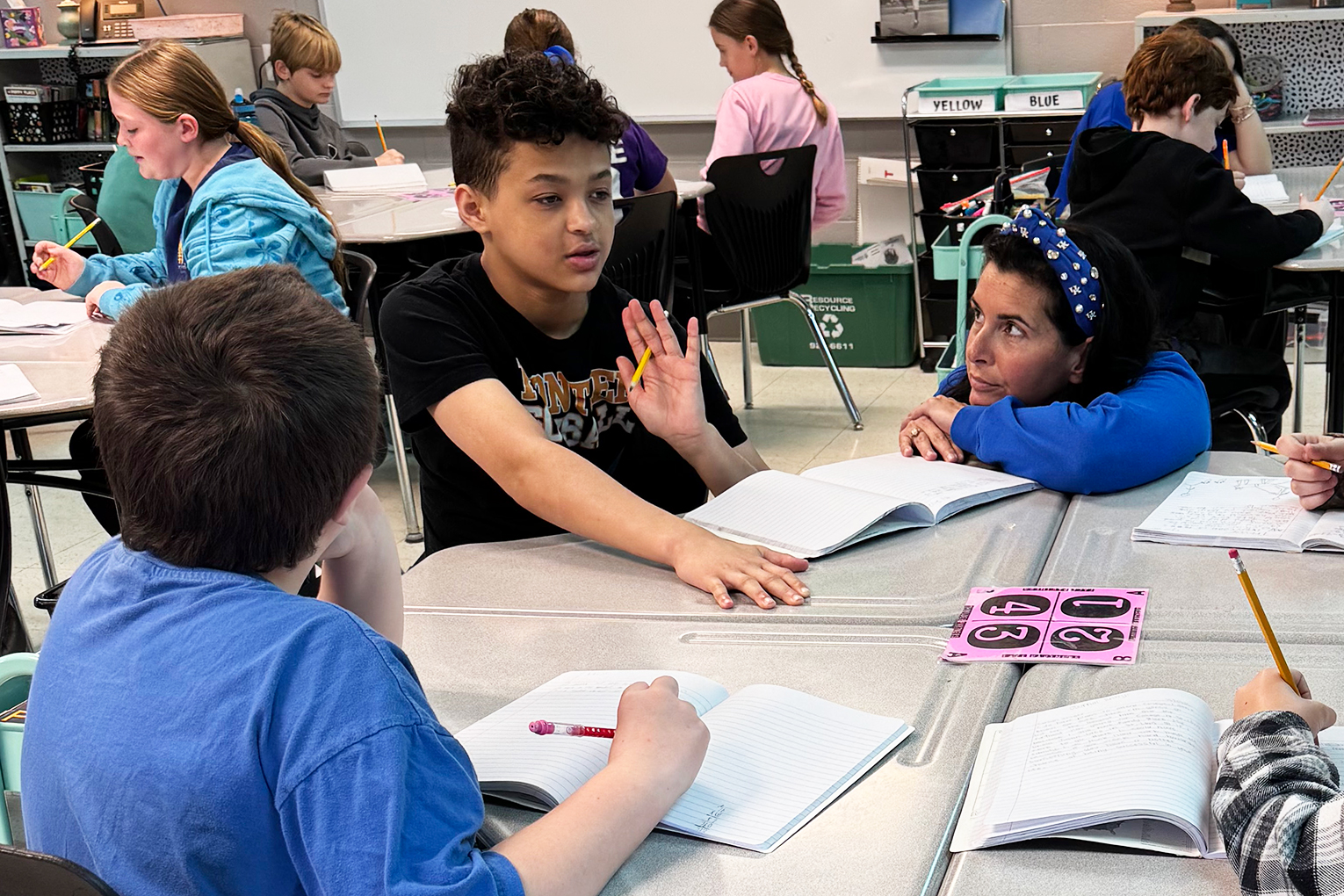
Emily Wilcoxson works with preschool students in her class at North Park Elementary School (Hardin County). Her class was recently named a Classroom of Excellence.
Photo by Amy Wallot, Feb. 27, 2014
Nannette Johnston is a product of the district she now leads, the Hardin County school district. A graduate of North Hardin High School, Johnston later taught at Parkway and Vine Grove elementary schools before becoming director of early childhood programs. In 2006, she was named interim superintendent of the district and, in 2007, she was named superintendent.
Additionally, she has been appointed to two governor’s task forces including the Interstate Compact on Educational Opportunities for Military Children and Transforming Education in Kentucky. She helps train new Kentucky superintendents and represents state superintendents on the Prichard Committee’s Strong Start Committee.
Here, Johnston answers questions regarding her district’s use of the BRIGANCE Kindergarten Readiness Screener.
How is your district using the kindergarten readiness data within the kindergarten setting – both for students who are ready and those who are not?
Hardin County Schools is using the data from the kindergarten screener as an instructional starting point for children who are
ready, not ready and ready with enrichments. Although it is helpful for children to enter knowing these readiness skills, if they do not a kindergarten teacher will take them where they are and move them forward. If they have already mastered these skills then the teacher will provide the student with instruction based on their zone of proximal development. For many years, our kindergarten teachers have developed and assessed children entering kindergarten using handmade screeners. The kindergarten screener allowed all children to be screened with a common tool that allows us to have open conversations with kindergarten teachers across the state.
How are you using the data to improve preschool in the district?
Every year, we look at any and all kindergarten data available (screeners, MAP data, surveys from kindergarten teachers, etc.) to see how our previous preschool students are doing. We use the data to spotlight areas where we made need to clarify our focus. Not only do we look at cognitive areas but we also look at social-emotional areas. Our goal in the Hardin County Schools preschool program is for our students to maximize their growth and be ready for success in kindergarten. We share student data information with all preschool staff and continuously work to improve our program. We also share all information about the kindergarten screener with preschool staff.
How are you using prior settings data with other early childhood education and child care providers?
We are using the prior setting data to analyze where are students are coming from prior to entering kindergarten. I think it has opened the door to more conversations about how our children are doing with school readiness. In preschool, we feel that we are partners with the child care providers. Since our program is a half-day program, the child care providers make up the other half of our school day. We are truly in this together because we both want the same thing: for our children to be school ready and successful. Our district recently adopted 20 child care providers (we have 20 preschool classrooms so each teacher team took a child care provider) and have made face-to-face visits to the child care to build our relationships. We provided goody bags and books and will make future visits. This is just an example of how important we think the child’s prior setting is and how we need to partner for the benefit of the child. We are very involved in our CECC and make many efforts to create community awareness of school readiness.
How are you using the kindergarten screener with parents and others in your community to encourage high quality cradle to career education?
We are creating opportunities to share the school readiness definition with parents, community members and child care providers. Our preschool classrooms post the readiness definition outside their classrooms. Our kindergarten staff held face-to-face conferences with many parents to share the results of the kindergarten screener. For parents who were not able to attend a conference, data was shared via telephone, e-mail, and reports. Our district provides literacy information for parents and a book to families with babies born at our local hospital, Hardin Memorial Hospital, in an initiative we call Books for Babies. We are in the process of distributing a readiness checklist to all childcare providers with the assistance of our CECC. Readiness brochures are shared with First Steps in an effort to get the information in the hands of families with birth to 3-year-old children.
What is your district doing to ensure more accurate and complete reporting on the kindergarten screener next year?
Our district shared all information from the Kentucky Department of Education with our entire kindergarten staff, administrators and school personnel throughout the initial phases of the screener. We volunteered for the pilot program in an effort to ensure accuracy in implementation. We provided training to all our kindergarten staff and support personnel throughout the summer. We carefully monitored the screening process and had open communication with all kindergarten staff. We were pleased with the data we collected in regard to prior setting and the children we screened. We are planning to follow similar plans and procedures this upcoming school year. Recently, we surveyed the kindergarten staff for their thoughts on our implementation with the kindergarten screener and for their suggestions on improving the process for the upcoming year. Clear and frequent communication with all staff helped ensure a smooth process.
How will this kindergarten screener data help support K-3 Program Reviews?
The kindergarten screener allows us to provide families with specific feedback on the skills to be mastered by their children. It also allows us to provide learning target-focused descriptive feedback to enhance student work. The data helps teachers target student needs and scaffold instruction. Program Reviews are intended to help schools focus on improving student performance and the kindergarten screener is also intended to help teachers target instruction to fit student needs and improve their instruction. The kindergarten screener data is one piece of data to use when planning instruction for students to be successful.
How can the kindergarten screener data be used to help close achievement gaps?
The data will be used to differentiate instruction based on the skills the children enter kindergarten having already mastered or not mastered. We close the achievement gap by removing the unknown for parents. Parents need to know the readiness skills as well as all prior setting people. If prior setting people do not know and understand the skills that help children enter school more successfully, than they can’t help the students learn those skills. It is very important that we are transparent with the community with the skills. We must continue to train all early childhood educators in developmentally appropriate practices and emphasize parent/family involvement.




Leave A Comment